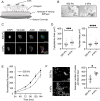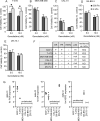Progesterone receptor expression contributes to gemcitabine resistance at higher ECM stiffness in breast cancer cell lines
- PMID: 35617163
- PMCID: PMC9135204
- DOI: 10.1371/journal.pone.0268300
Progesterone receptor expression contributes to gemcitabine resistance at higher ECM stiffness in breast cancer cell lines
Abstract
Chemoresistance poses a great barrier to breast cancer treatment and is thought to correlate with increased matrix stiffness. We developed two-dimensional (2D) polyacrylamide (PAA) and three-dimensional (3D) alginate in vitro models of tissue stiffness that mimic the stiffness of normal breast and breast cancer. We then used these to compare cell viability in response to chemotherapeutic treatment. In both 2D and 3D we observed that breast cancer cell growth and size was increased at a higher stiffness corresponding to tumours compared to normal tissue. When chemotherapeutic response was measured, a specific differential response in cell viability was observed for gemcitabine in 2 of the 7 breast cancer cell lines investigated. MCF7 and T-47D cell lines showed gemcitabine resistance at 4 kPa compared to 500 Pa. These cell lines share a common phenotype of progesterone receptor (PGR) expression and, indeed, pre-treatment with the selective progesterone receptor modulator (SPRM) mifepristone abolished resistance to gemcitabine at high stiffness. Our data reveals that combined treatment with SPRMs may therefore help in reducing resistance to gemcitabine in stiffer breast tumours which are PGR positive.
Conflict of interest statement
The authors have declared that no competing interests exist.
Figures






Similar articles
-
Preclinical studies of gemcitabine and trastuzumab in breast and lung cancer cell lines.Clin Breast Cancer. 2002 May;3 Suppl 1:12-6. doi: 10.3816/cbc.2002.s.003. Clin Breast Cancer. 2002. PMID: 12057039 Review.
-
The Cisplatin, 5-fluorouracil, Irinotecan, and Gemcitabine Treatment in Resistant 2D and 3D Model Triple Negative Breast Cancer Cell Line: ABCG2 Expression Data.Anticancer Agents Med Chem. 2022;22(2):371-377. doi: 10.2174/1871520621666210727105431. Anticancer Agents Med Chem. 2022. PMID: 34315389
-
Correlation between erythropoietin receptor(s) and estrogen and progesterone receptor expression in different breast cancer cell lines.Int J Mol Med. 2013 Mar;31(3):717-25. doi: 10.3892/ijmm.2013.1231. Epub 2013 Jan 8. Int J Mol Med. 2013. PMID: 23314808
-
Progesterone and levonorgestrel regulate expression of 17βHSD-enzymes in progesterone receptor positive breast cancer cell line T47D.Biochem Biophys Res Commun. 2012 May 25;422(1):109-13. doi: 10.1016/j.bbrc.2012.04.116. Epub 2012 Apr 30. Biochem Biophys Res Commun. 2012. PMID: 22564730
-
Gemcitabine in combination with trastuzumab and/or platinum salts in breast cancer cells with HER2 overexpression.Oncology (Williston Park). 2004 Dec;18(14 Suppl 12):32-6. Oncology (Williston Park). 2004. PMID: 15685824 Review.
Cited by
-
The impact of glucocorticoid receptor transactivation on context-dependent cell migration dynamics.Sci Rep. 2025 Feb 4;15(1):4163. doi: 10.1038/s41598-025-88666-1. Sci Rep. 2025. PMID: 39905197 Free PMC article.
-
Facilitation of Tumor Stroma-Targeted Therapy: Model Difficulty and Co-Culture Organoid Method.Pharmaceuticals (Basel). 2025 Jan 8;18(1):62. doi: 10.3390/ph18010062. Pharmaceuticals (Basel). 2025. PMID: 39861125 Free PMC article. Review.
-
Progesterone receptor potentiates macropinocytosis through CDC42 in pancreatic ductal adenocarcinoma.Oncogenesis. 2024 Feb 29;13(1):10. doi: 10.1038/s41389-024-00512-7. Oncogenesis. 2024. PMID: 38424455 Free PMC article.
-
Vitronectin-based hydrogels recapitulate neuroblastoma growth conditions.Front Cell Dev Biol. 2022 Oct 11;10:988699. doi: 10.3389/fcell.2022.988699. eCollection 2022. Front Cell Dev Biol. 2022. PMID: 36425532 Free PMC article.
-
Predictive miRNAs Patterns in Blood of Breast Cancer Patients Demonstrating Resistance Towards Neoadjuvant Chemotherapy.Breast Cancer (Dove Med Press). 2023 Aug 11;15:591-604. doi: 10.2147/BCTT.S415080. eCollection 2023. Breast Cancer (Dove Med Press). 2023. PMID: 37593370 Free PMC article.
References
-
- Nelli F, Moscetti L, Natoli G, Massari A, D’Auria G, Chilelli M, et al.. Gemcitabine and carboplatin for pretreated metastatic breast cancer: the predictive value of immunohistochemically defined subtypes. International Journal of Clinical Oncology. 2013;18(2):343–9. doi: 10.1007/s10147-012-0384-x - DOI - PubMed
-
- Dangi-Garimella S, Krantz SB, Barron MR, Shields MA, Heiferman MJ, Grippo PJ, et al.. Three-dimensional collagen I promotes gemcitabine resistance in pancreatic cancer through MT1-MMP-mediated expression of HMGA2. Cancer Res. 2011;71(3):1019–28. Epub 2010/12/15. doi: 10.1158/0008-5472.CAN-10-1855 ; PubMed Central PMCID: PMC3076124. - DOI - PMC - PubMed
Publication types
MeSH terms
Substances
Grants and funding
LinkOut - more resources
Full Text Sources
Medical
Research Materials

